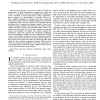Free Online Productivity Tools
i2Speak
i2Symbol
i2OCR
iTex2Img
iWeb2Print
iWeb2Shot
i2Type
iPdf2Split
iPdf2Merge
i2Bopomofo
i2Arabic
i2Style
i2Image
i2PDF
iLatex2Rtf
Sci2ools
TCOM
2010
2010
Transmission Radius Control in Wireless Ad Hoc Networks with Smart Antennas
—In this paper, we present a model to analyze the performance of three transmission strategies with smart antennas, i.e. directional antennas with adjustable transmission power. Generally, a larger transmission radius contributes a greater progress if a transmission is successful. However, it has a higher probability of collision with other concurrent transmissions. Smart antennas mitigate collisions with sectorized transmission ranges. They also extend the transmission radii. By modelling three transmission strategies, namely, Nearest with Forward Progress (NFP), Most Forward with Fixed Radius (MFR), and Most Forward with Variable Radius (MVR), our analysis illustrates that the use of smart antennas can greatly reduce the possibility of conflicts. The model considers the interference range and computes the interference probability for each transmission strategy. We have analyzed two Medium Access Control (MAC) protocols using our interference model, namely, the slotted ALOHA protoc...
| Added | 30 Jan 2011 |
| Updated | 30 Jan 2011 |
| Type | Journal |
| Year | 2010 |
| Where | TCOM |
| Authors | Fei Huang, Ka-Cheong Leung, Victor O. K. Li |
Comments (0)

